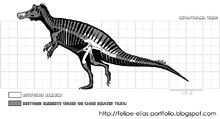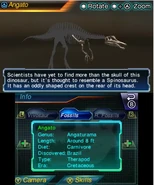| Angaturama | |
|---|---|

| |
| Skeleton reconstruction of Angaturama limai | |
| Scientific classification | |
| Kingdom: | Animalia |
| Phylum: | Chordata |
| Class: | Sauropsida |
| Superorder: | Dinosauria |
| Order: | Saurischia |
| Suborder: | Theropoda |
| Family: | †Spinosauridae |
| Subfamily: | †Baryonychinae |
| Genus: | Angaturama |
| Binomial name | |
| Angaturama limai Kellner & Campos, 1996 | |
Angaturama (AHN-gah-too-RAH-ma - ((Tupi Indian) meaning "noble, brave") is a dubious/uncertain genus of spinosaurid theropod from the Early Cretaceous Santana Formation of northeastern Brazil. The type specimen was discovered in a limestone nodule and consisted of the incomplete anterior portion of a skull. A description of the new species, A. limai by Alexander W.A. Kellner and Diogenes de A. Campos was published in February 1996. It was named after Angaturama, a protective spirit in the aboriginal Tupi Indian culture of Brazil, and paleontologist Murilo R. de Lima, who informed Kellner of the specimen in 1991. Later research uncovered 60% of the complete skeleton, allowing a replica to be made and mounted for an exhibit at the Federal University-owned Rio de Janeiro National Museum.[1]
Angaturama was diagnosed by the very strong lateral compression of the snout, and a thin sagittal crest (shape unknown) on top of the premaxillae. A pterosaur fossil was found with an Angaturama tooth embedded in it, pointing to possible predation.
Angaturama was originally described as "the first remain of a dinosaur skull described from Brazil." However, as the paper describing Angaturama was in press, a partial spinosaurid skull from Brazil, bought from illegal fossil dealers, was published under the name Irritator. Many paleontologists suspect Angaturama and Irritator are the same dinosaurs, in which case the name Irritator has priority.
Gallery[]

A Reconstruction of the species, based on irritator reconstruction with recovered remains.
References[]
- Kellner, A.W.A. & D.A. Campos, 1996. First Early Cretaceous dinosaur from Brazil with comments on Spinosauridae. N. Jb. Geol. Paläont. Abh. 199 (2): 151-166.



